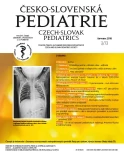Diagnostics, treatment and prognosis of congenital hypothyroidism
Authors:
E. Al Taji
Authors‘ workplace:
Klinika dětí a dorostu, 3. lékařská fakulta Univerzity Karlovy a Fakultní nemocnice Královské Vinohrady, Praha
Published in:
Čes-slov Pediat 2018; 73 (3): 158-164.
Category:
Review
Věnováno památce paní profesorky MUDr. Jiřiny Čížkové-Písařovicové, DrSc. (1908–1994) a paní profesorky MUDr. Olgy Hníkové, CSc. (1931–2017)
Overview
Congenital hypothyroidism is the most frequent inborn endocrine disorder and the most frequent disease diagnosed by nation-wide newborn screeening. 80–85% of permanent cases is caused by a defective thyroid development – thyroid dysgenesis. Remaining cases are caused by defects of thyroid hormone biosynthesis – dyshormonogenesis. Early and adequate substitution treatment together with a good family compliance are the main factors playing role in psychomotor, mental and somatic development of the majority of children with congenital hypothyroidism.
Key words:
congenital hypothyroidism, neonatal screening, substitution treatment, thyroid dysgenesis, dyshormonogenesis
Sources
1. Čížková-Písařovicová J. Štítná žláza – thyreoidea. In: Čížková--Písařovicová J. Klinická endokrinologie dětského věku. Praha: Státní zdravotnické nakladatelství, 1954 : 37–40.
2. Hubble D. Diseases of the thyroid gland. In: Hubble D. Paediatric Endocrinology. Oxford and Edinburgh: Blackwell Scientific Publication, 1969 : 113–154.
3. Klein AH, Meltzer S, Kenny FM. Improved prognosis in congenital hypothyroidism treated before age three months. J Pediatr 1972; 81 (5): 912–915.
4. Vulsma T, Gons MH, de Vijlder JJ. Maternal-fetal transfer of thyroxine in congenital hypothyroidism due to a total organification defect or thyroid agenesis. N Engl J Med 1989; 321 (1): 13–16.
5. Hníková O, Kračmar P. Kongenitální hypotyreóza. 1. vyd. Praha: Avicenum, 1989 : 1–100.
6. Léger J, Olivieri A, Donaldson M, et al. On behalf of ESPE-PES-SLEP--JSPE-APEG-APPES-ISPAE, and the Congenital hypothyroidism consensus conference group. European society for paediatric endocrinology consensus guidelines on screening, diagnosis, and management of congenital hypothyroidism. Horm Res Paediatr 2014; 81 (2): 80–103.
7. Grosse SD, Van Vliet G. Prevention of intellectual disability through screening for congenital hypothyroidism: how much and at what level? Arch Dis Child 2011; 96 (4): 374–379.
8. Ford G, LaFranchi SH. Screening for congenital hypothyroidism: a worldwide view of strategies. Best Pract Res Clin Endocrinol Metab 2014; 28 (2): 175–178.
9. Metodický návod k zajištění novorozeneckého laboratorního screeningu a následné péče. In: Věstník Ministerstva zdravotnictví České republiky 2016; částka 6 : 2–12.
10. Perry R, Heinrichs C, Bourdoux P, et al. Discordance of monozygotic twins for thyroid dysgenesis: implications for screening and for molecular pathophysiology. J Clin Endocrinol Metab 2002; 87 (9): 4072–4077.
11. Al Taji E, Biebermann H, Límanová Z, et al. Screening for mutations in transcription factors in a Czech cohort of 170 patients with congenital and early-onset hypothyroidism: identification of a novel PAX8 mutation in dominantly inherited early-onset non-autoimmune hypothyroidism. Eur J Endocrinol 2007; 156 (5): 5212–5229.
12. Indicators for asssessing iodine deficiency disorders and their control through salt iodization. Geneva: WHO, ICCIDD, UNICEF, 1994 : 1–53.
13. Grüters A, Delange F, Giovannelli G, et al. Guidelines for neonatal screening programmes for congenital hypothyroidism. Working group on congenital hypothyrodisim of the European society for paediatric endocrinology. Eur J Pediatr 1993; 152 (12): 974–975.
14. Wasniewska M, De Luca F, Cassio A, et al. In congenital hypothyroidism bone maturation at birth may be a predictive factor of psychomotor development during the first year of life irrespective of other variables related to treatment. Eur J Endocrinol 2003; 149 (1): 1–6.
15. Grüters A, Jenner A, Krude H. Long-term consequences of congenital hypothyroidism in the era of screening programmes. Best Pract Res Clin Endocrinol Metab 2002; 16 (2): 369–382.
16. Olivieri A, Stazi MA, Mastroiacovo P, et al. A population-based study of the frequency of additional congenital malformations in infants with congenital hypothyroidism: data from the Italian registry for congenital hypothyroidism (1991-1998). J Clin Endocrinol Metab 2002; 87 (2): 557–562.
17. Azar-Kolakez A, Ecosse E, Dos Santos S, et al. All-cause and disease-specific mortality and morbidity in patients with congenital hypothyroidism treated since the neonatal period: a national population-based study. J Clin Endocrinol Metab 2013; 98 (2): 2012–2731.
18. Lebl J, Al Taji E, Koloušková S, et al. Tyreopatie. In: Lebl J, Al Taji E, Koloušková S, et al. Dětská endokrinologie a diabetologie. Praha: Galén, 2016 : 189–235.
19. Donaldson M, Jones J. Optimising outcome in congenital hypothyroidism, current opinions on best practice in initial assessment and subsequent management. J Clin Res Pediatr Endocrinol 2013; 5 (Suppl 1): 13–22.
20. Albert BB, Heather N, Derraik JSB, et al. Neurodevelopmental and body composition outcomes in children with congenital hypothyroidism treated with high-dose initial replacement and close monitoring. J Clin Endocrinol Metab 2013; 98 (9): 3663–3670.
21. Krude H, Kühnen P, Biebermann H. Treatment of congenital thyroid dysfunction: achievements and challanges. Best Pract Clin Endocrinol Metab 2015; 25 : 399–413.
22. Léger J, Ecosse E, Roussey M. Subtle health impairment and socioeducational attainment in young adult patients with congenital hypothyroidism diagnosed by neonatal screening: a longitudinal population-based cohort study. J Clin Endocrinol Metab 2011; 96 (6): 1771–1782.
23. Hassani Y, Larroque B, Dos Santos S, et al. Fecundity in young adults treated early for congenital hypothyroidism is related to the initial severity of the disease: a longitudinal population-based cohort study. J Clin Endocrinol Metab 2012; 97 (6): 704–710
Labels
Neonatology Paediatrics General practitioner for children and adolescentsArticle was published in
Czech-Slovak Pediatrics

2018 Issue 3
- What Effect Can Be Expected from Limosilactobacillus reuteri in Mucositis and Peri-Implantitis?
- The Importance of Limosilactobacillus reuteri in Administration to Diabetics with Gingivitis
Most read in this issue
- C3 glomerulopathy – a new clinical entity
- Current approach to asthma diagnosis and treatment in children
- News in cardiopulmonary resuscitation – „guidelines 2018“
- Macro AST – cause of asymptomatic aspartate aminotransferase elevation – case report
